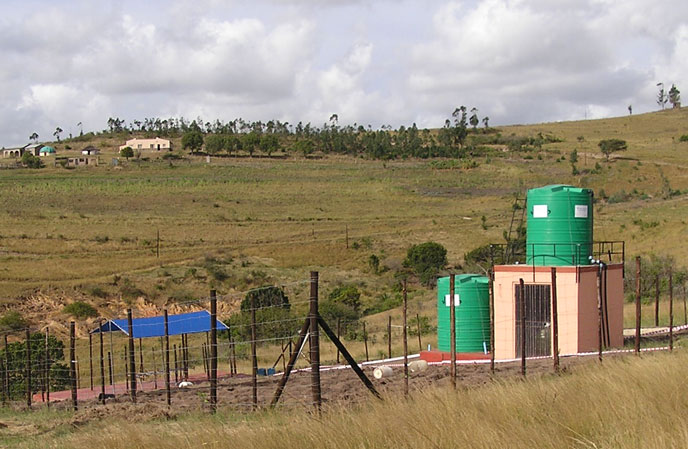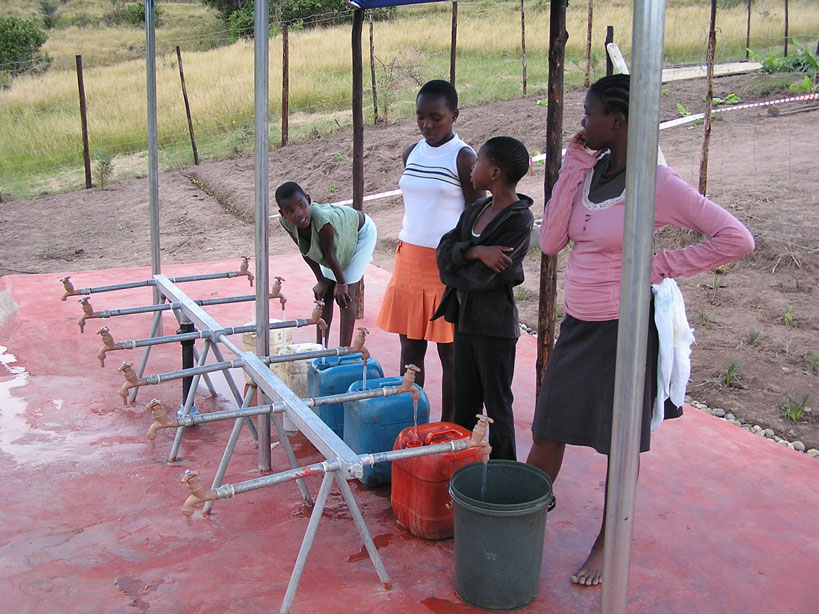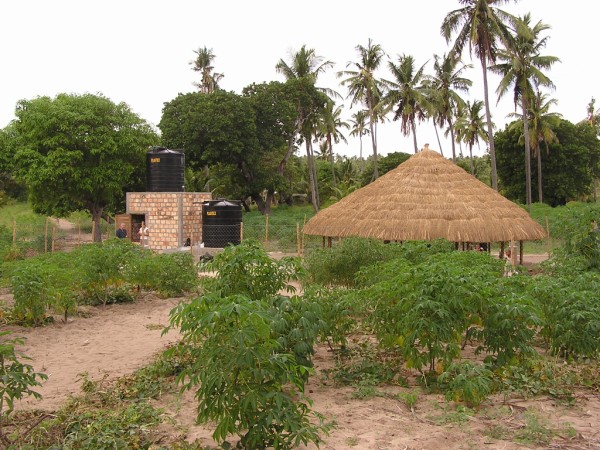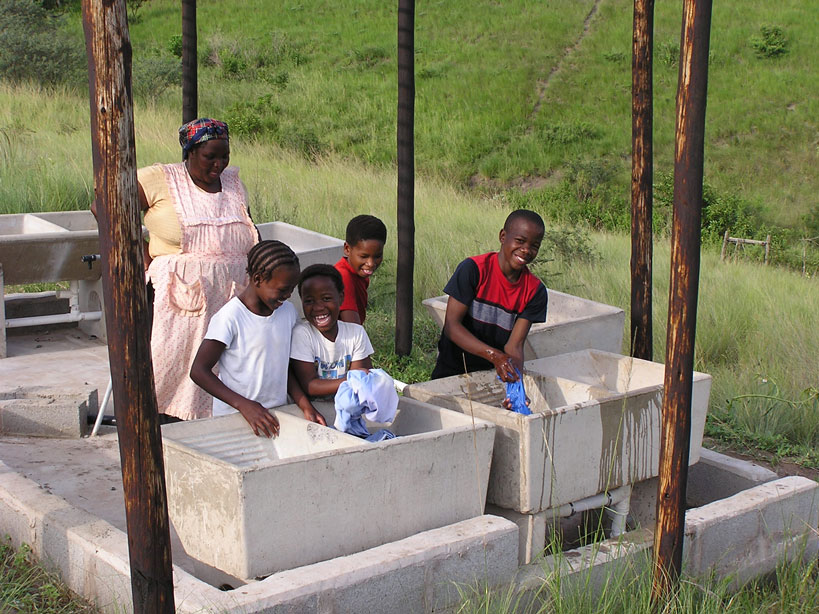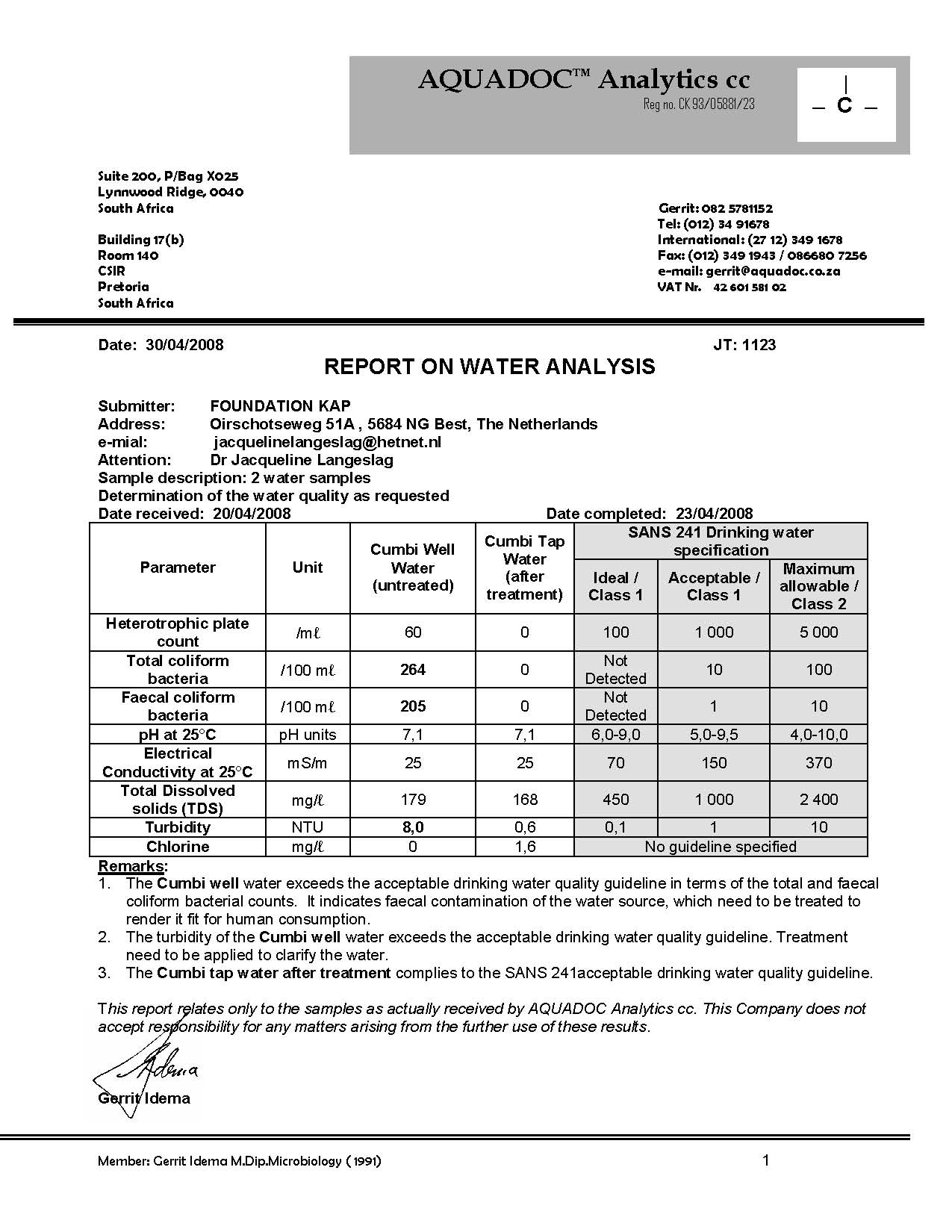Difference between revisions of "QuaWater Village Solution"
| (25 intermediate revisions by 3 users not shown) | |||
| Line 1: | Line 1: | ||
| − | __NOTOC__ | + | [[Image:VillageSolution2.jpg|thumb|right|200px| Overview of Village Solution Elomoya 2 in KwaZuluNatal, South Africa]] |
| − | + | [[Image:VillageSolution4.jpg|thumb|right|200px| Children using tap stations at Village Solution Elomoya 2 in KwaZuluNatal, South Africa]] | |
| − | + | __NOTOC__ <small-title /> | |
| + | QuaWater Village Solution (TM) is a stand-alone system, designed together with a South African CBO to provide a permanent, multi-purpose water supply wherever surface water is available. It uses a combination of proven technologies to purify contaminated ground or surface water and supply safe drinking water. Depending on local needs other features, such as utility water for washing or water for cattle and irrigation can be added. Where needed provisions are made for the protection of the water source. | ||
| − | + | ===Suitable conditions === | |
| − | + | Up to 2000 people can be served with drinking and utility water and the system can be easily scaled up. | |
| + | {| border="1" cellpadding="5" cellspacing="0" align="center" | ||
| + | |- | ||
| + | ! width="50%" style="background:#efefef;" | Advantages | ||
| + | ! style="background:#f0f8ff;" | Disadvantages | ||
| + | |- | ||
| + | | valign="top" | - Stand-alone system <br> | ||
| + | - Modules can be added for utility water, water for animals and irrigation <br> | ||
| + | - Suitable for any place where surface or ground water is available <br> | ||
| + | - Suitable for purifying water from contaminated wells and boreholes <br> | ||
| + | - Short installation time; 1 to 6 weeks <br> | ||
| + | - Simple to operate and maintain <br> | ||
| + | - Durable; all materials and parts used are long life <br> | ||
| + | - Economical; low investment costs and affordable running costs <br> | ||
| + | - Easily expandable when needing to serve bigger communities or incorporate other modules <br> | ||
| + | | valign="top" | - Standard unit does not address chemical contamination of source water | ||
| + | |} | ||
| − | |||
| − | |||
| − | |||
| − | |||
| − | |||
| − | |||
| − | |||
| − | |||
| − | |||
| − | |||
{{Potential_Treatment_Capacity_table | {{Potential_Treatment_Capacity_table | ||
| highly= | | highly= | ||
| Line 25: | Line 32: | ||
- Snails<br> | - Snails<br> | ||
- Viruses<br> | - Viruses<br> | ||
| + | - Turbudity<br> | ||
- Colloidal parts | - Colloidal parts | ||
| somewhat= | | somewhat= | ||
| − | - | + | - Protozoa<br> |
| − | - | + | - Colour |
| − | |||
| − | |||
| not= | | not= | ||
| − | - Dissolved Chemicals (such as pesticides, fertilizers, arsenic etc.) | + | - Dissolved Chemicals (such as pesticides, fertilizers, arsenic etc.) |
| − | | process= | + | | process=Flocculation, sand filtration and chlorination |
| − | | watcrit= | + | | watcrit=Fresh water, not contaminated with dissolved chemicals. |
}} | }} | ||
| + | ===Operations and maintenance=== | ||
| + | [[Image:VillageSolution1.jpg|thumb|right|200px| Beautifully finished Village Solution project at Cumbi, Mozambique]] | ||
| + | |||
| + | The Village Solution is designed to be reliable, easily operated, and maintained and repairable. The treatment process involves basic and proven technologies that provide reliable purification and quality control. No electronics or automated moving parts are used. <br> | ||
| + | <br> | ||
| + | <b>Standard QuaWater Village Solution technical specifications:</b> | ||
| + | |||
| + | <b>Tanks:</b> Two 5000 litre <br> | ||
| + | <b>Outlets:</b> Two multi-point tap stations <br> | ||
| + | <b>Connections:</b> All pipes, valves and fittings included <br> | ||
| + | <b>Pump:</b> Petrol driven, max. 40m head <br> | ||
| + | <b>Purification:</b> Flocculation, sand filtration, chlorination <br> | ||
| + | |||
| + | <br> | ||
| + | The system can easily be scaled up to serve larger communities, and additional modules are available to cater for specific local needs: <br> | ||
| + | • Wash basins are added when on-site washing is required <br> | ||
| + | • Cattle troughs can be made to reduce the likelihood of cattle contaminating the source water <br> | ||
| + | • Irrigation systems for local agriculture can be connected to the system <br> | ||
| + | • Dam extensions, well supports or other source protection can be installed to safeguard the water source.<br> | ||
| + | |||
| + | ====How does it remove contamination?==== | ||
| + | [[Image:VillageSolution6.jpg|thumb|right|200px| Wash basins at Village Solution Elomoya 1 being used.]] | ||
| + | |||
| + | Water purification in the Village Solution uses the following methods: <br> | ||
| + | 1. Screening <br> | ||
| + | 2. Flocculation <br> | ||
| + | 3. Sand filtration <br> | ||
| + | 4. Chlorination <br> | ||
| + | <br> | ||
| + | QuaWater makes an initial assessment of the area and tests the raw water quality. From this information the purification needs are determined and together with the local partners the set-up of the complete water purification system is decided upon. Solutions are offered to each community addressing their specific needs.<br> | ||
| + | |||
| + | A team of local people, led by QuaWater or a supervisor appointed by QuaWater, then prepare the site, lay foundations and set up the main elements of the Village Solution. The finalisation, testing and commissioning of the system is carried out by QuaWater professionals. | ||
| − | + | Treatment of water is done in batches of 5000 litres, and depending on local situation 4 to 5 batches of purified drinking water can be produced every day. The final product water is clear - low turbidity - and safe – inactivated pathogenic microorganisms. The water produced by the Village Solution is tested on a regular basis to ensure proper functioning of the system. Flocculant and chlorine dosages are adjusted in response to the results of this analysis. <br> | |
| − | + | Connections and valves are installed to regulate the flow to the various modules installed in the particular system. Managers are appointed from the local population and trained by QuaWater for operating and maintaining the unit. Spare- and replacement parts can usually be purchased locally and repairs carried out by the local managers. <br> | |
====Treatment Efficiency==== | ====Treatment Efficiency==== | ||
| + | [[Image:QWVS_Cumbi_water_analysis.jpg|thumb|right|200px| Water analysis results from Village Solution project in Cumbi, Mozambique]] | ||
| + | <br> | ||
{{Treatment_Efficiency | {{Treatment_Efficiency | ||
| − | |lab:bacteria= | + | |lab:bacteria=Up to 100% |
| − | |lab:viruses= | + | |lab:viruses=Up to 100% |
| − | |lab:protozoa=> | + | |lab:protozoa=>99% |
| − | |lab:helminths= | + | |lab:helminths=Up to 100% |
| − | |lab:turbidity= | + | |lab:turbidity=<1 NTU |
| − | |lab:iron= | + | |lab:iron=Not available |
| − | |field:bacteria= | + | |field:bacteria=Up to 100% |
| − | |field:viruses= | + | |field:viruses=Not available |
| − | |field:protozoa= | + | |field:protozoa=Not available |
| − | |field:helminths= | + | |field:helminths=Not available |
| − | |field:turbidity= | + | |field:turbidity=<2 NTU |
| − | |field:iron= | + | |field:iron=Not available |
| − | |extra_field= | + | |extra_field=- |
| − | |lab:extra= | + | |lab:extra=- |
| − | |field:extra= | + | |field:extra=- |
}} | }} | ||
| − | + | QuaWater offers follow-up visits to check proper operation of the unit and to test the water produced over time.<br> | |
| − | + | Field efficiencies stated above are based on analysis results from Elomoya 2, KwaZuluNatal, South Africa, 11/12/2008. Analysis carried out by AquaDoc Analytics CC. <br> | |
| − | |||
| − | |||
| + | ====Maintenance==== | ||
| + | The Village Solution requires very minimal and basic maintenance: <br> | ||
| + | • Pump maintenance requires the occasional replacement of spark plugs, refilling and replacement of oil, and cleaning of the air filter <br> | ||
| + | • The inlet strainer will have to be cleared of any accumulated dirt occasionally. <br> | ||
| + | • Sand filters need to be washed approximately every 12 months. <br> | ||
| − | == | + | ===Costs=== |
{{Treatment_Cost | {{Treatment_Cost | ||
| − | |CapCost=US$ | + | |CapCost=US$ 15,000 - 20,000 |
| − | |OpCost=US$ | + | |OpCost=US$ 0.5 - 1.0 per 1000 litres |
| − | |ReplCost=US$ | + | |ReplCost=US$ - |
| − | |5yCost=US$ | + | |5yCost=US$ 2500 |
| − | |litreCost=US$ < | + | |litreCost=US$ <0.001 |
}} | }} | ||
| − | + | <b>Capital costs</b> include: <br> | |
| − | + | • All equipment and materials for a standard Village Solution <br> | |
| − | + | • Commissioning; including independent water analysis <br> | |
| + | • Training of local managers for operating and maintaining the system <br> | ||
| + | • 6 months of consumables. <br> | ||
| + | • VAT and transport not included. <br> | ||
| + | <br> | ||
| + | <b>Installation costs</b> consist of the construction of the project site and depending on local costs this can range from roughly US$5000 in South Africa to as much as US$10,000 in South Sudan. <br> | ||
| − | + | [[Image:VillageSolution9.jpg|thumb|right|200px| A young boy is about to taste the safe drinking water produced by the Village Solution]] | |
| − | + | <b>Operating costs</b> consist of: <br> | |
| − | + | • Petrol for pump <br> | |
| + | • Chlorine <br> | ||
| + | • Flocculant <br> | ||
| + | • Salary of the managers. <br> | ||
| + | <br> | ||
| + | <b>5-year costs</b> consist of maintenance and if needed replacement costs for various items. <br> | ||
| − | + | ===Field experiences=== | |
| + | The following Village Solution systems have been successfully installed to date:<br> | ||
| + | <b>Elomoya 1</b>; KwaZuluNatal, South Africa, 2006; 400 beneficiaries <br> | ||
| + | <b>Mjejane</b>; Mpumalanga, South Africa, 2007; 1500 beneficiaries <br> | ||
| + | <b>Cumbi</b>; Inhambane, Mozambique, 2008; 2000 beneficiaries <br> | ||
| + | <b>Nhambunia</b>; Inhambane, Mozambique, 2008; 4000 beneficiaries (scaled-up version) <br> | ||
| + | <b>Elomoya 2</b>; KwaZuluNatal, South Africa, 2008; 800 beneficiaries <br> | ||
| + | <b>Rajaf</b>; Central Equatoria, South Sudan, 2009; 950 beneficiaries <br> | ||
| − | == | + | ===Manuals, videos and links=== |
| + | AKVO Project Partner QuaWater: [http://www.akvo.org/rsr/organisation/105/] <br> | ||
| − | == | + | ===Company Information=== |
| − | + | [[Image:quawater.jpg|right|200px|]] | |
| − | + | <b>QuaWater (Pty) Ltd</b> <br> | |
| + | <br> | ||
| + | Visitor address: <br> | ||
| + | CSIR Campus <br> | ||
| + | Building 17B, <br> | ||
| + | Room 117 <br> | ||
| + | Meiring Naudé Road <br> | ||
| + | Brummeria, Pretoria <br> | ||
| + | South Africa <br> | ||
| + | <br> | ||
| + | Postal address: <br> | ||
| + | P.O. Box 72461 <br> | ||
| + | Lynnwood Ridge <br> | ||
| + | 0040 <br> | ||
| + | South Africa <br> | ||
| + | <br> | ||
| − | + | T: +27 (0)123 492 820 <br> | |
| + | F: +27 (0)866 676 299 <br> | ||
| + | E: info[[Image:At.png|14px]]quawater.com <br> | ||
| + | W: [http://www.quawater.com www.quawater.com]<br> | ||
Latest revision as of 22:35, 11 November 2015
QuaWater Village Solution (TM) is a stand-alone system, designed together with a South African CBO to provide a permanent, multi-purpose water supply wherever surface water is available. It uses a combination of proven technologies to purify contaminated ground or surface water and supply safe drinking water. Depending on local needs other features, such as utility water for washing or water for cattle and irrigation can be added. Where needed provisions are made for the protection of the water source.
Suitable conditions
Up to 2000 people can be served with drinking and utility water and the system can be easily scaled up.
| Advantages | Disadvantages |
|---|---|
| - Stand-alone system - Modules can be added for utility water, water for animals and irrigation |
- Standard unit does not address chemical contamination of source water |
|
|
Operations and maintenance
The Village Solution is designed to be reliable, easily operated, and maintained and repairable. The treatment process involves basic and proven technologies that provide reliable purification and quality control. No electronics or automated moving parts are used.
Standard QuaWater Village Solution technical specifications:
Tanks: Two 5000 litre
Outlets: Two multi-point tap stations
Connections: All pipes, valves and fittings included
Pump: Petrol driven, max. 40m head
Purification: Flocculation, sand filtration, chlorination
The system can easily be scaled up to serve larger communities, and additional modules are available to cater for specific local needs:
• Wash basins are added when on-site washing is required
• Cattle troughs can be made to reduce the likelihood of cattle contaminating the source water
• Irrigation systems for local agriculture can be connected to the system
• Dam extensions, well supports or other source protection can be installed to safeguard the water source.
How does it remove contamination?
Water purification in the Village Solution uses the following methods:
1. Screening
2. Flocculation
3. Sand filtration
4. Chlorination
QuaWater makes an initial assessment of the area and tests the raw water quality. From this information the purification needs are determined and together with the local partners the set-up of the complete water purification system is decided upon. Solutions are offered to each community addressing their specific needs.
A team of local people, led by QuaWater or a supervisor appointed by QuaWater, then prepare the site, lay foundations and set up the main elements of the Village Solution. The finalisation, testing and commissioning of the system is carried out by QuaWater professionals.
Treatment of water is done in batches of 5000 litres, and depending on local situation 4 to 5 batches of purified drinking water can be produced every day. The final product water is clear - low turbidity - and safe – inactivated pathogenic microorganisms. The water produced by the Village Solution is tested on a regular basis to ensure proper functioning of the system. Flocculant and chlorine dosages are adjusted in response to the results of this analysis.
Connections and valves are installed to regulate the flow to the various modules installed in the particular system. Managers are appointed from the local population and trained by QuaWater for operating and maintaining the unit. Spare- and replacement parts can usually be purchased locally and repairs carried out by the local managers.
Treatment Efficiency
| Bacteria | Viruses | Protozoa | Helminths | Turbidity | Iron | {{{extra_Field}}} | |
|---|---|---|---|---|---|---|---|
| Laboratory | Up to 100% | Up to 100% | >99% | Up to 100% | <1 NTU | Not available | - |
| Field | Up to 100% | Not available | Not available | Not available | <2 NTU | Not available | - |
QuaWater offers follow-up visits to check proper operation of the unit and to test the water produced over time.
Field efficiencies stated above are based on analysis results from Elomoya 2, KwaZuluNatal, South Africa, 11/12/2008. Analysis carried out by AquaDoc Analytics CC.
Maintenance
The Village Solution requires very minimal and basic maintenance:
• Pump maintenance requires the occasional replacement of spark plugs, refilling and replacement of oil, and cleaning of the air filter
• The inlet strainer will have to be cleared of any accumulated dirt occasionally.
• Sand filters need to be washed approximately every 12 months.
Costs
| Captial Cost | Operation Cost | Replacement Cost | Estimated 5 years Cost | Cost/liter treated |
|---|---|---|---|---|
| US$ 15,000 - 20,000 | US$ 0.5 - 1.0 per 1000 litres | US$ - | US$ 2500 | US$ <0.001 |
Capital costs include:
• All equipment and materials for a standard Village Solution
• Commissioning; including independent water analysis
• Training of local managers for operating and maintaining the system
• 6 months of consumables.
• VAT and transport not included.
Installation costs consist of the construction of the project site and depending on local costs this can range from roughly US$5000 in South Africa to as much as US$10,000 in South Sudan.
Operating costs consist of:
• Petrol for pump
• Chlorine
• Flocculant
• Salary of the managers.
5-year costs consist of maintenance and if needed replacement costs for various items.
Field experiences
The following Village Solution systems have been successfully installed to date:
Elomoya 1; KwaZuluNatal, South Africa, 2006; 400 beneficiaries
Mjejane; Mpumalanga, South Africa, 2007; 1500 beneficiaries
Cumbi; Inhambane, Mozambique, 2008; 2000 beneficiaries
Nhambunia; Inhambane, Mozambique, 2008; 4000 beneficiaries (scaled-up version)
Elomoya 2; KwaZuluNatal, South Africa, 2008; 800 beneficiaries
Rajaf; Central Equatoria, South Sudan, 2009; 950 beneficiaries
Manuals, videos and links
AKVO Project Partner QuaWater: [1]
Company Information
QuaWater (Pty) Ltd
Visitor address:
CSIR Campus
Building 17B,
Room 117
Meiring Naudé Road
Brummeria, Pretoria
South Africa
Postal address:
P.O. Box 72461
Lynnwood Ridge
0040
South Africa
T: +27 (0)123 492 820
F: +27 (0)866 676 299
E: info![]() quawater.com
quawater.com
W: www.quawater.com
